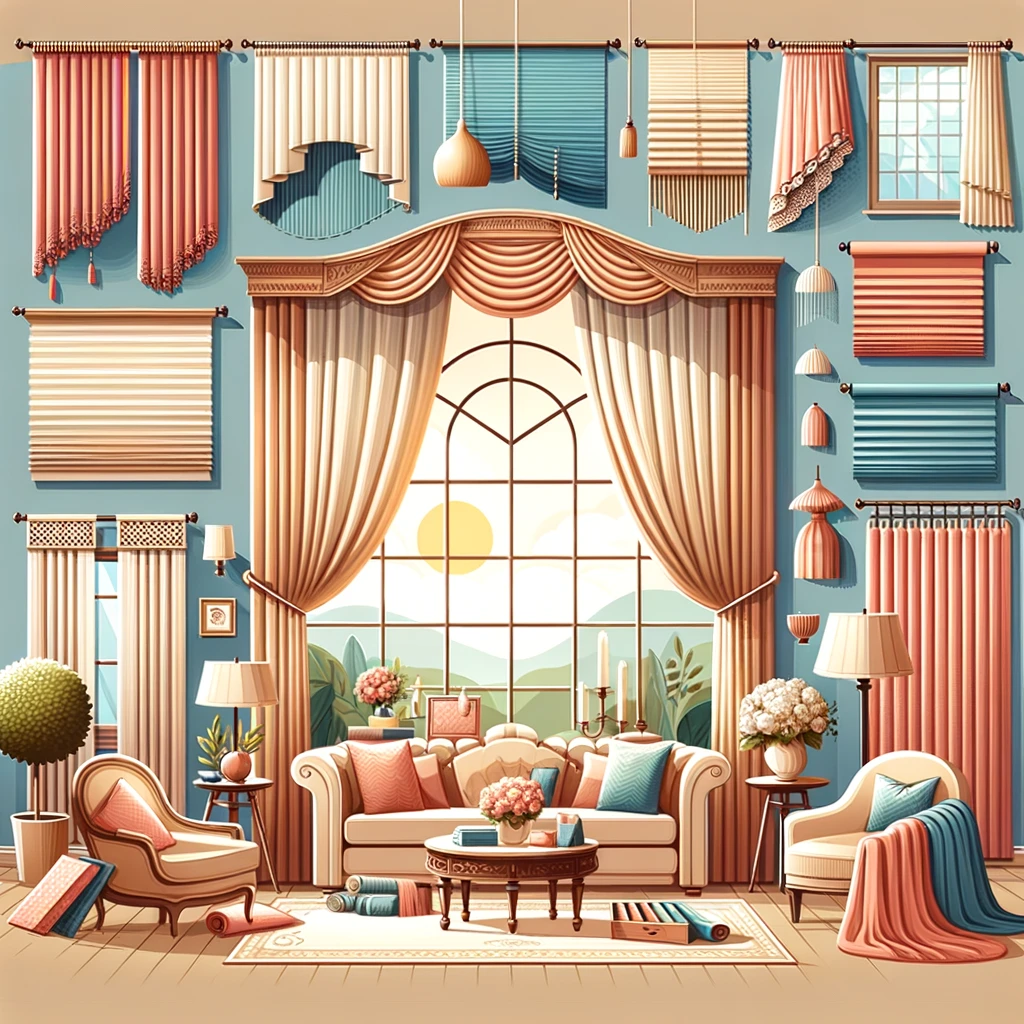
Basic Principles
- Elevating Room Height with Drapery Placement: It is imperative to install drapery as proximal to the ceiling or crown molding as feasible. Such placement not only engenders an impression of heightened vertical space but also contributes to an aura of sophistication and elegance within the room. This method effectively alters the perceived proportions of the space, thereby amplifying its overall grandeur.
- Incorporating Contrast to Enhance Drapery Length: Should the drapery not sufficiently reach the desired length, it is advisable to affix a contrasting band at the base. This strategy serves not only to visually elongate the drapery but also introduces a distinct element of visual interest. It ensures the extended portion does not appear as a mere afterthought but as an intentional design choice that coheres with the room’s aesthetic scheme.
Window Treatment Options
- Flat Fold Roman Shades – A Synthesis of Modernity and Elegance: These shades are ideally suited for environments aspiring to a contemporary and uncluttered aesthetic. Characterized by their clean lines, flat fold Roman shades excel in spaces that demand a modern ambiance devoid of superfluous fabric. They are particularly adept at complementing narrow or uniquely shaped windows, thereby melding functionality with style without overwhelming the spatial aesthetics.
- Strategic Layering for Enhanced Functionality: The practice of layering sheer and blackout-lined drapery within bedrooms exemplifies the pinnacle of versatility in managing privacy and light penetration. This approach facilitates a finely tuned modulation of natural illumination and privacy, adjustable to varying times of day and individual preferences. Experimentation with various combinations, such as positioning sheer Roman shades beneath more substantial curtains, allows for a dynamically customizable window dressing solution.
- Top Down Bottom Up Shades for Privacy Without Compromise: These shades are quintessential for spaces where privacy requisites coexist with the desire to maintain natural light influx and external vistas. Their design permits privacy control without obliterating access to sunlight or scenic views, making them particularly advantageous for windows overlooking patios or expansive outdoor areas. Their utility is underscored in settings with large windows or sliding doors, where managing light and privacy is paramount.
- Material Selection Tailored to Room Function and Desired Atmosphere: The selection of fabric types for window treatments should be judiciously informed by the intended function of the room and the ambiance one wishes to cultivate. For instance, bathrooms derive significant benefits from sheer fabrics, which while ensuring privacy, also permit the gentle diffusion of light. Conversely, living areas may be better served by heavier linens, which add both texture and depth, thus enriching the room’s sensory and aesthetic appeal.
Practical Tips and Tricks for Installation
- Precise Measurement: It is imperative to ensure that shades exceed the window's width slightly and extend just below the sill to facilitate a bespoke appearance that enhances both the aesthetic and functional aspects of the room. This meticulous approach to measurement ensures that the window treatments appear tailor-made for the space, contributing significantly to the overall visual appeal.
- Light Control Options: Selecting the appropriate linings is critical for achieving the desired level of light control within a space, ranging from translucent sheers that allow a soft diffusion of light to opaque blackout linings designed to completely obscure light. This choice should be reflective of the room’s specific requirements regarding privacy and light control to ensure an optimal living environment at any time of the day.
- Pattern Consideration: Special attention must be paid to the appearance of fabric patterns when they are folded or pleated, particularly in the case of Roman shades. This consideration is paramount in preserving the design's aesthetic integrity, as the way a pattern manifests when condensed or expanded can significantly alter its visual impact within the space.
- Hardware Choices: The adoption of cordless mechanisms is recommended to achieve a sleek, uncluttered appearance while simplifying the operation of shades, especially in locations that are challenging to access. It is advisable to position shades as close to the ceiling as feasible to foster an illusion of heightened space, thereby enhancing the perceived dimensions of the room.
Final Touches: Adding Style and Personality
- Inside vs. Outside Mount: The decision between inside and outside mounts should be informed by the architecture of the window and the stylistic preferences of the homeowner. Inside mounts contribute to a minimalist aesthetic, whereas outside mounts have the potential to visually enlarge the appearance of windows, offering a strategic method for enhancing spatial perceptions.
- Accessorizing: The application of decorative rods, unique trims, and contrasting borders serves to infuse window treatments with layers of texture, color, and personality. This strategic embellishment of window dressings is instrumental in elevating the overall design scheme, enabling a customized and cohesive interior aesthetic.
Maintenance and Adjustment
- Regular Maintenance: The longevity and visual appeal of window treatments are contingent upon regular maintenance, including cleaning and dusting, to preserve their pristine condition. This routine upkeep is essential in maintaining the aesthetic quality of the treatments over time.
- Adjustments and Updates: To rejuvenate or update the appearance of window treatments without undergoing a complete overhaul, homeowners may consider the addition of new bands, trims, or the layering of different window treatment types. This approach allows for seasonal refreshes or stylistic shifts within the space, facilitating a dynamic and adaptable décor strategy.






